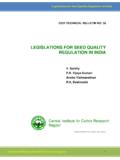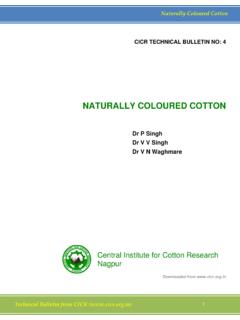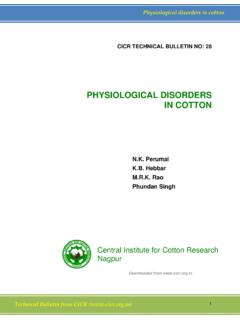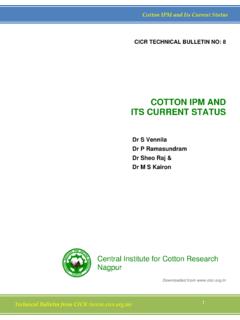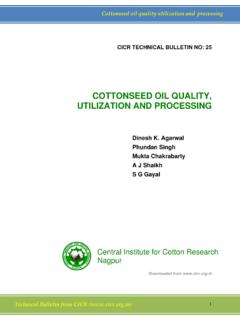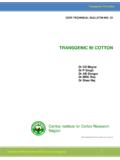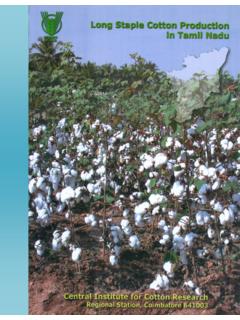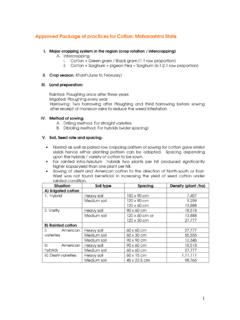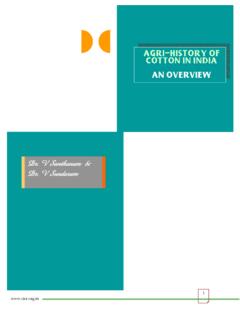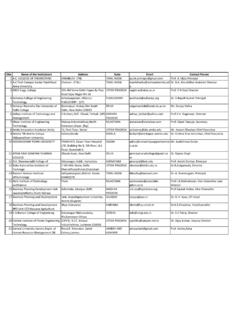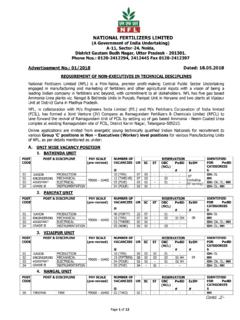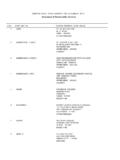Transcription of COTTON VARIETIES AND HYBRIDS-modified
1 technical Bulletin from CICR ( ) 1 COTTON VARIETIES and Hybrids CICR technical BULLETIN NO: 13 COTTON VARIETIES and Hybrids Dr. Phundan Singh Dr. MS Kairon Downloaded from Central Institute for COTTON Research Nagpur technical Bulletin from CICR ( ) 2 COTTON VARIETIES and Hybrids COTTON VARIETIES AND HYBRIDS INTRODUCTION COTTON is a fibre, oil and protein yielding crop of global significance. It is cultivated in tropical and sub-tropical regions of more than 80 countries of the world.
2 The major COTTON producing countries are USA, China, India, Pakistan, Uzbekistan, Turkey, Brazil, Greece, Argentina and Egypt. These countries contribute about 85% to the global COTTON production. India stands first in area, third in production and last in productivity among these countries. In India, there are nine major COTTON growing states which are divided into three zones, viz. north zone, central zone and south zone. North zone consists of Punjab, Haryana, Rajasthan and Western Uttar Pradesh.
3 Central zone includes Madhya Pradesh, Maharashtra and Gujarat. South zone comprises Andhra Pradesh, Karnataka and Tamil Nadu. These states cover about 95% of COTTON area and also contribute about 95% to the total COTTON production in India. Three COTTON growing zones differ from each other in several aspects such as soil type and topography, irrigation facilities, species cultivated, productivity level etc. (Table-1). Besides these states, COTTON is also grown on small areas in Bihar, Orissia, Assam, Tripura and Meghalaya.
4 These states cover about 5% area and also contribute 5% to the national COTTON production. Table-1: Comparison of three COTTON growing zones. Particulars North zone Central Zone South Zone 1. Soil type Alluvial Black soils Black and red soils 2. Soil topography Plain Undulating Undulating 3. Irrigation 98% 15% 32% 4. Species cultivated Hirsutum, arboreum All except barbadense All the four species 5. Hybrid cultivation Less than 1% 55% 50% 6.
5 Area covered 20% 55% 25% 7. Production 40% 35% 25% 8. Yield level High Low Medium CULTIVATED SPECIES There are four cultivated species of COTTON viz. Gossypium arboreum, , and The first two species are diploid (2n=26) and are native to old world. They are also known as Asiatic cottons because they are grown in Asia. The last two species are tetraploid (2n=52) and are also referred to as New World Cottons.
6 Is also known as American COTTON or upland COTTON and as Egyptian COTTON or Sea Island COTTON or Peruvian COTTON or Tanguish COTTON or quality is the predominant species which alone contributes about 90% to the global production. In USA and Uzbekistan, more than 90% area is covered by Perhaps, India is the only country in the world where all the four cultivated species are grown on commercial scale. In India, 45%, 30% and area is covered by hybrids, upland COTTON and diploid species respectively.
7 Is grown on a very little area ( ) in the state of Tamil Nadu and Andhra Pradesh. is limited to the states of Gujarat and Karnataka. and are grown in all the major COTTON growing states in India. Distinguishing morphological features of all the four cultivated species of COTTON are given in Table-2. Gossypium arboretum Bracts are more or less triangular and closely invest bud and flower. Bracts have 4-5 teeth at the apex. Bolls are tapering and profusely pitted with prominent oil glands. Bolls open widely on maturity.
8 This species is also known as Indian COTTON . technical Bulletin from CICR ( ) 3 COTTON VARIETIES and Hybrids Gossypium herbaceum Bracts flare widely from the bud, flower and boll. They have 6-8 teeth. Bolls are round and rarely with prominent shoulders. Bolls are smooth or with few shallow pits and few oil glands. Bolls open slightly when ripe. Table-2: Distinguishing morphological features of cultivated species of Gossypium Linn. Particulars Cultivated Species of COTTON 1.
9 Leaves 1/2cut or less into 3-5 lobes, not constricted, also over lapping lobes 2/3 cut into 3-5 lobes, sinuses thrown into folds, lobes long and tapering 2/3-4/5 cut into 5-7 lobes long and narrow cut or less 3-7 lobes only slightly constricted at the base. 2. Bracteoles Triangular, 4-12 long teeth As long as broad, 10-12 acuminate teeth Closely investing the bud and flower, entire or with fewer teeth longer than broad. Bracteoles not investing bud, usually broader than long upper margin serrated.
10 3. Petal Light yellow to yellow Sulphur yellow, deep Yellow White to yellow, red Medium yellow 4. Bolls Round to moderately tapering 3-5 locular, 4 common smooth to moderately pitted. Tapering, longer than broad 3-4 usually 3 loculi, deeply pitted and glanded often, rough Moderate Round to tapering, 3 to 4 loculi, 3 common smooth to deeply pitted, rough Rounded, smaller, 3 loculi smooth to moderately pitted. 5. Seeds Moderately large, fuzzy to rarely naked, moderate to long fibres, 5-11 seed/locule 5-8 seeds/locule, tuft of fuzz on seeds, seeds often without a coat of a fuzz, lint fibres very long, seeds free Fuzzy, smaller rarely naked, 6-17 seeds/locule Medium size to small fuzzy, 11 seeds/locule, short to medium fibres.
